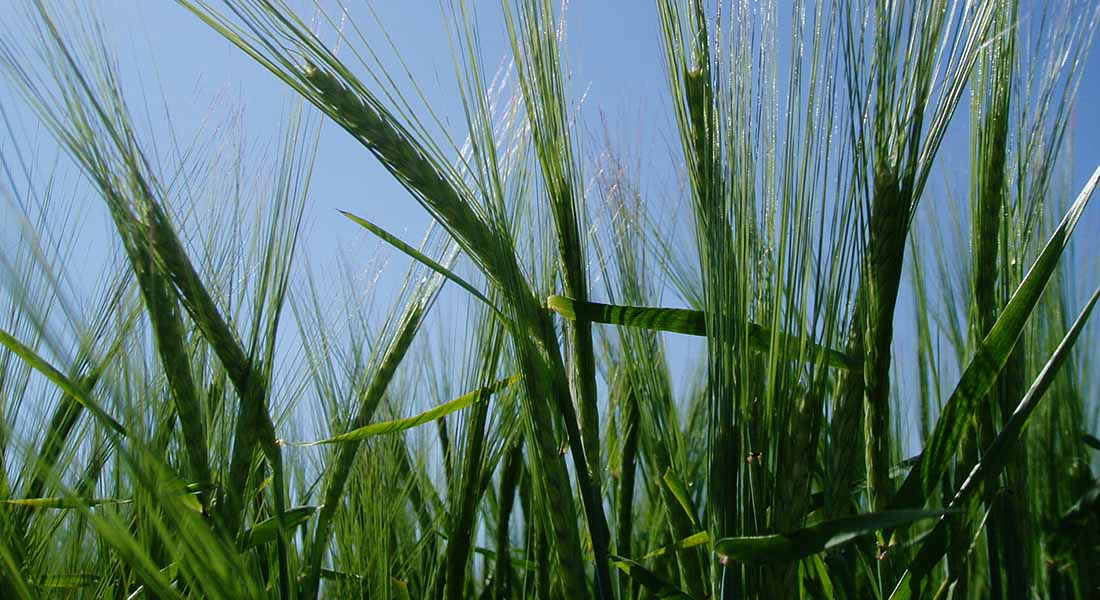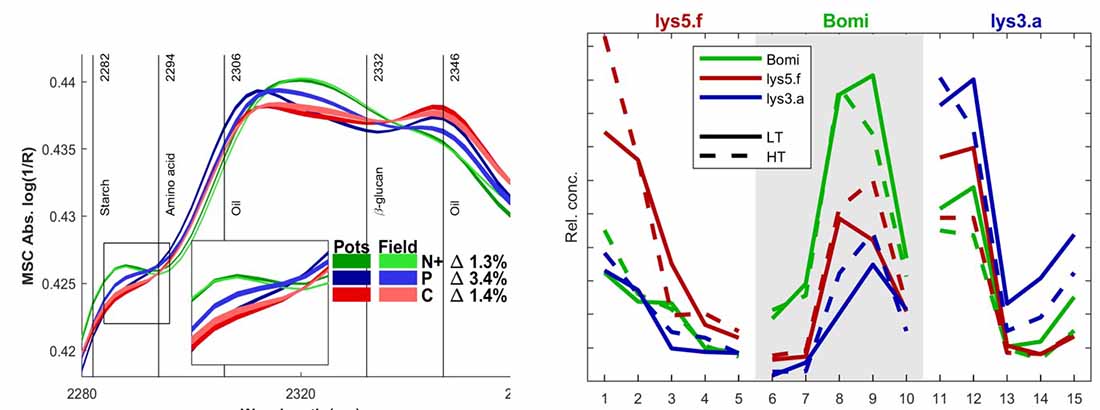Researchers show new holistic approach to genetics and plant breeding
A group of researchers has discovered a new approach to cereal plant breeding that takes into account the internal "calculator" of plant seeds that makes them continuously reorganise themselves (global coherence). The approach includes unforeseen and unintended changes in the plant when genetically manipulated by the plant breeders. The researchers expect that the method can be used to improve the world's crops much more efficiently.

The research was conducted at the Department of Food Science at the University of Copenhagen (UCPH FOOD) with professor emeritus Lars Munck as coordinator and builds on earlier work since 1963 at Svalöf Plant Breeding Institute and the Carlsberg Laboratory.
A complete picture of the organism
The research shows how, with the help of a fast, non-destructive and green analysis method, near-infrared spectroscopy (NIRS), we can obtain a global overview that mirrors how the entire chemical composition of nutrients in a barley grain is changed, for example, by a mutation in a single gene. This is in contrast to current conventional plant breeding, where you do not have an overview of all the changes that the barley grain undergoes when a single gene is modified.
Lars Munck and his team have studied barley grains from different barley lines using near-infrared spectroscopy (NIRS). In a split second, this method can provide a “chemical fingerprint” (see below) of the barley grains, which describes the chemical-physical composition of the grains, including the nutrients. The researchers analysed the resulting intact spectra by comparing and calibrating them to barley lines of known composition using mathematics (chemometrics).
“We were surprised by the precision that characterises the chemical fingerprints of the grains from the NIRS spectra. At the same time, it surprised us to find that we got the same classification result if we instead used the secondary nutrients/metabolites determined by a more complicated measurement method called gas chromatography mass spectrometry as the chemical fingerprint. Using two different types of analysis with completely different focuses, we arrived at the same classification result,” explains Lars Munck and continues:
“This is coherence in a nutshell – all local fingerprints are part of the plant’s self-organising network and affect the plant’s overall global chemical-physical fingerprints.”
One of the barley lines examined was found to have a higher content of the essential amino acid lysine compared to a normal barley. The high content of lysine gives good growth in feeding studies with pigs, but the yield in the field was horrible and with a low starch content.
“By analysing the high-lysine barley lines that were crossed with high starch barley lines bringing high yield, we could use measurements of NIRS fingerprints to select lines with a high content of both lysine and starch, which thus gave higher yields. At the same time, global coherence also allowed us to gain knowledge about the optimal combination of genetic traits for a specific quality purpose,” explains Lars Munck, who believes that this is a radical advancement compared to today's plant breeding that is focused on one gene-chemical trait combination at a time.
“With a more holistic approach allowed by the NIRS method – we can instead examine the chemical fingerprint totality of the different plant lines, and quickly obtain an overview of what material is available and thus target and select lines from the variable crossing pool that are high quality by calibrating to interesting marker lines” says Lars Munck.
Global coherence – the inner self-organisation of the plant
In the discipline of plant breeding, people speak of the genotype, which describes the plant’s genetic material, and the phenotype, which describes the traits that can be observed directly or can be measured chemically and thus may be characterised using NIRS.
The approach when using NIRS phenotyping is to change the order of the plant breeding procedure to start by screening the different barley lines for all of their chemical properties represented by fingerprints. This is done by calibrating to known barley lines that have one or more of the desired chemical properties (e.g., high starch content). Only at the end when you have selected the optimal barley line, you make an in-depth determination of the genes that are changed. When searching for an expression for the whole organism, using NIRS fingerprints provides a far more nuanced result, allowing you to examine the overall chemistry of an organism rather than examining each individual gene combination separately. Because coherence guarantees that all fingerprint aspects of an individual communicate you can manage the global composition from very different fingerprint positions.
“With the new method, we have closed the large knowledge gap that exists in the genetics between genotype and phenotype. Now molecular biology will finally have an outlet for its impressive library of primary gene functions, where the result of total contribution of changed genes to a functioning plant can now be studied as a whole,” says Lars Munck and continues:
“Molecular biology has come up with crucial solutions for genetic diseases, resistance and vaccinations against diseases. But in this success story, we have forgotten that it is not the gene that is the biological unit, but that it is the self-organised individual that uses its inner “calculator” to organise the internal interaction coherence precisely and reproducibly,” says Lars Munck.
The researchers call this interaction, which is shown in barley grains using NIRS fingerprints and which they believe can be transferred to all living organisms, global coherence.
“When change occurs in a single or in several of the plant’s genes or in the environment, the chemistry and the implicit morphology of the whole organism changes as the plant reorganises itself to obtain a new coherent balance point. This unifying force, coherence, was previously defined in the physics between light beams and atoms in non-living matter and we have now discovered coherence in biology as a macroscopic chemical fingerprint, that we call global coherence. It explains how living matter can replicate itself into recognizable individuals,” explains Lars Munck.
The importance of the introduction of macroscopic chemical fingerprint coherence in biology that coordinates physical morphological structures with chemical is a fundamental discovery and highly simplifying complement to molecular genetic in-depth understand to gene expression.

Topics
Related News
Contact
Professor emeritus at the Department of Food Science at the University of Copenhagen (UCPH FOOD) Lars Munck, larsmunck.r@icloud.com
Associate professor at UCPH FOOD Aasmund Rinnan, aar@food.ku.dk
Associate professor at UCPH FOOD Birthe P. Møller Jespersen, bm@food.ku.dk
Professor at UCPH FOOD Soren Balling Engelsen, se@food.ku.dk
Communications officer at UCPH FOOD Lene Hundborg Koss, lene.h.koss@food.ku.dk
The scientific article
Original title: Physiological Genetics reformed: Bridging the genome-to-phenome gap by coherent chemical fingerprints – the global coordinator
The authors are:
Lars Munck, Åsmund Rinnan, Bekzod Khakimov, Birthe Møller Jespersen, Søren Balling Engelsen, all from the Department of Food Science at the University of Copenhagen (UCPH FOOD)
In the article, the researchers call global coherence fingerprints by means of near-red spectroscopy: macroscopic-physio-chemical-quantum coherence
The article is published in the scientific journal Trends in Plant Science and how the following doi-number: 10.1016/j.tplants.2020.12.014
Near-infrared spectroscopy
Near-infrared spectroscopy (NIRS) is an analytical method that can be used to determine the content of macroscopic chemical components such as water, protein, fat and carbohydrates and their interactions in biological materials – in this context, barley grains from different barley lines. It is a fast method, and the results are available a few seconds after transillumination. An analysis is carried out by characterising infrared light that has either illuminated or reflected from the biological sample material, here the barley grain. With the knowledge of how light interacts with the grain, a “fingerprint” of the chemical composition can be taken, from which it is possible to calculate the content of specific components using mathematics/chemometrics. These can be whole families of components, such as the total content of protein or carbohydrates, or very specific substances, such as a specific fatty acid or a specific vitamin. The method is non-destructive as the light does not affect the sample material (the barley sample) and green, as the method does not use chemicals unlike most other analytical methods.
Facts about Lars Munck
Lars Munck, b. 1935, Danish-Swedish plant breeder and food technologist; prominent advocate of a paradigm shift in science away from reductionism towards a holistic view of nature. Harmony between human cognition and the surrounding nature must be based on the recognition of the brain’s limited ability to interpret large simultaneous amounts of data. Multivariate and exploratory data analysis should be substituted. As research manager at the Carlsberg Research Center from 1973-91, Munck developed complete quality management and decision-making systems for malt houses and mills. As a professor of food technology at the Royal Veterinary and Agricultural University (now UCPH-FOOD) from 1991, he worked with online quality control in the food industry based on chemometrics, image analysis and fluorescence spectroscopy.
Source: The Great Danish Encyclopedia
